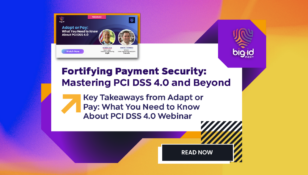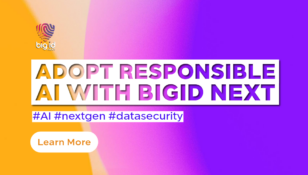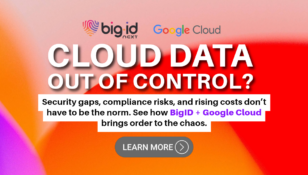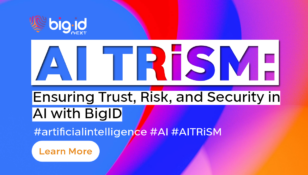Data Access Governance (DAG): Safeguarding Sensitive Data
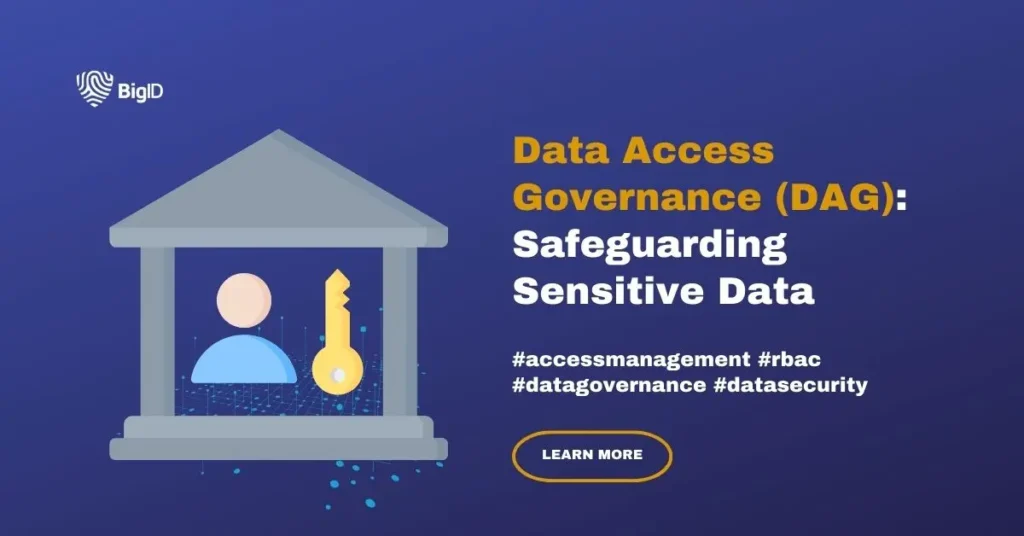
Data Access Governance: Control and Monitor Access to Sensitive Data
Protect your mission-critical data from prying eyes with data access governance. Learn how it can help you manage access to sensitive data.
What Is Data Access Governance (DAG)?
Data access governance (DAG) is an essential part of data governance. The approach uses policies, processes, and technologies to manage who can access, view, and use your organization’s data. It ensures that only authorized individuals can access sensitive data, and only at the right time.
DAG employs role-based access control (RBAC) and attribute-based access control (ABAC) to define and enforce data privacy.
You can use RBAC to assign permissions based on user roles, or ABAC, which uses attributes like user role, location, and time to dynamically manage access permissions.
The idea is to protect your organization’s sensitive information from users who don’t have permission to view it and thereby prevent potential breaches.
The main objectives of data access governance solutions are to:
- Identify and address threats to sensitive and valuable data
- Ensure secure data storage
- Enforce proper access permissions
Robust data access governance uses a range of activities to achieve these objectives. It defines roles and responsibilities, sets up procedures for granting and revoking access, and audits data access regularly.
As more data moves to the cloud, its volume and complexity increase. Cloud data access governance software helps you follow data protection regulations by creating an organized system to manage access to data and minimize risks.
Key Principles of Data Governance
- Transparency: Ensure that data collection and usage are clear and auditable
- Data Quality: Collect information accurately and reliably
- Accountability: Foster ownership and stewardship of data assets
- Standardization: Create uniform definitions and processes across the organization
- Collaboration: Enable teams to work together effectively on data governance
You must also regularly undertake risk assessments to implement effective data access governance. Additionally, you should also review privacy policy implementation, and continuously monitor data access.
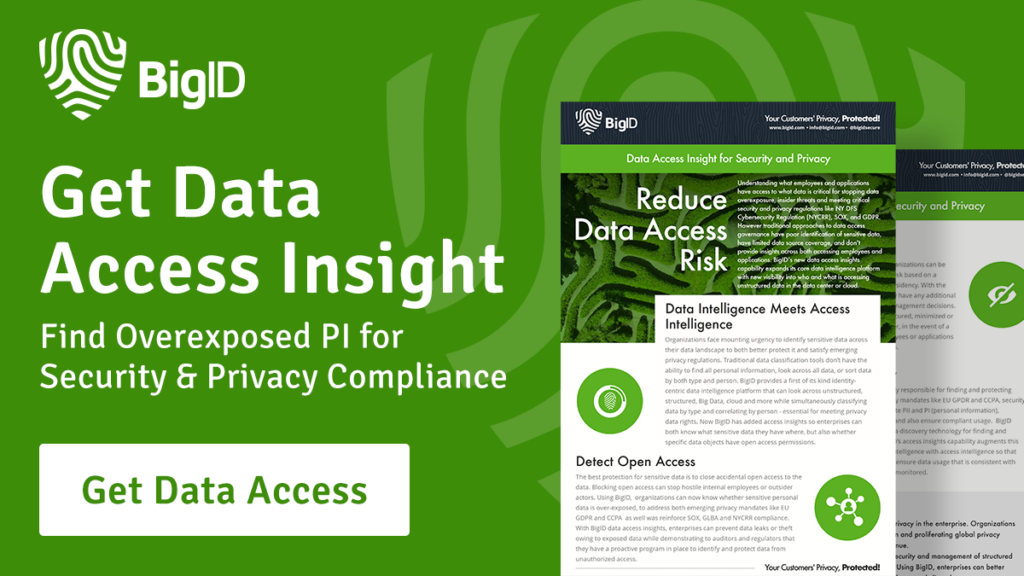
How Does Data Access Governance Work?
Sensitive Data Discovery
Before you can control access to your data, you must first discover it. Businesses collect vast troves of information over the years. At some point, they lose track of what information they own and where it resides.
If your business has been collecting data, it’s quite likely that some of it is not mapped.
To govern it effectively, you must locate these data repositories and classify the information based on its sensitivity, importance, and usage. Part of the process also involves identifying stale data.
Data Classification
Data classification involves tagging the data stored with metadata to indicate its level of sensitivity. Understanding how sensitive the information is helps you determine the appropriate security measures and policies for the governance process.
Classifying data also helps you prioritize sensitive information, such as personally identifiable information (PII), health information (PHI), payment card information (PCI), financial information, authentication information, and customer and employee data.
Access Control Implementation
Once this data has been located and classified, you as the data owner can implement governance mandates with zero-trust data access control. A core principle of zero-trust is the least privilege access, which ensures users only have the minimal level of access necessary to perform their roles. This approach minimizes potential security risks by reducing unnecessary exposure to sensitive information.
Access control measures may include encryption, access monitoring, and regular audits.
Encryption ensures that data remains secure even if it is intercepted. Monitoring and audits help you identify and respond to unauthorized access attempts.
As a result, your business can stay compliant with local data protection regulations, such as the General Data Protection Regulation (GDPR) in Europe, the California Consumer Privacy Act (CCPA), or the Health Insurance Portability and Accountability Act (HIPAA) in the United States.
Risk Assessment
Finally, risk assessment allows you to identify any threats to data security and integrity. Your team can assess the risk’s impact and likelihood, which helps them implement the right safeguards and solutions.
In short, DAG works by helping you answer the following questions:
- Where is your business-critical data located?
- How sensitive is it?
- Is it protected from unauthorized access?
- Has it been at risk of access without permission or been shared inappropriately?
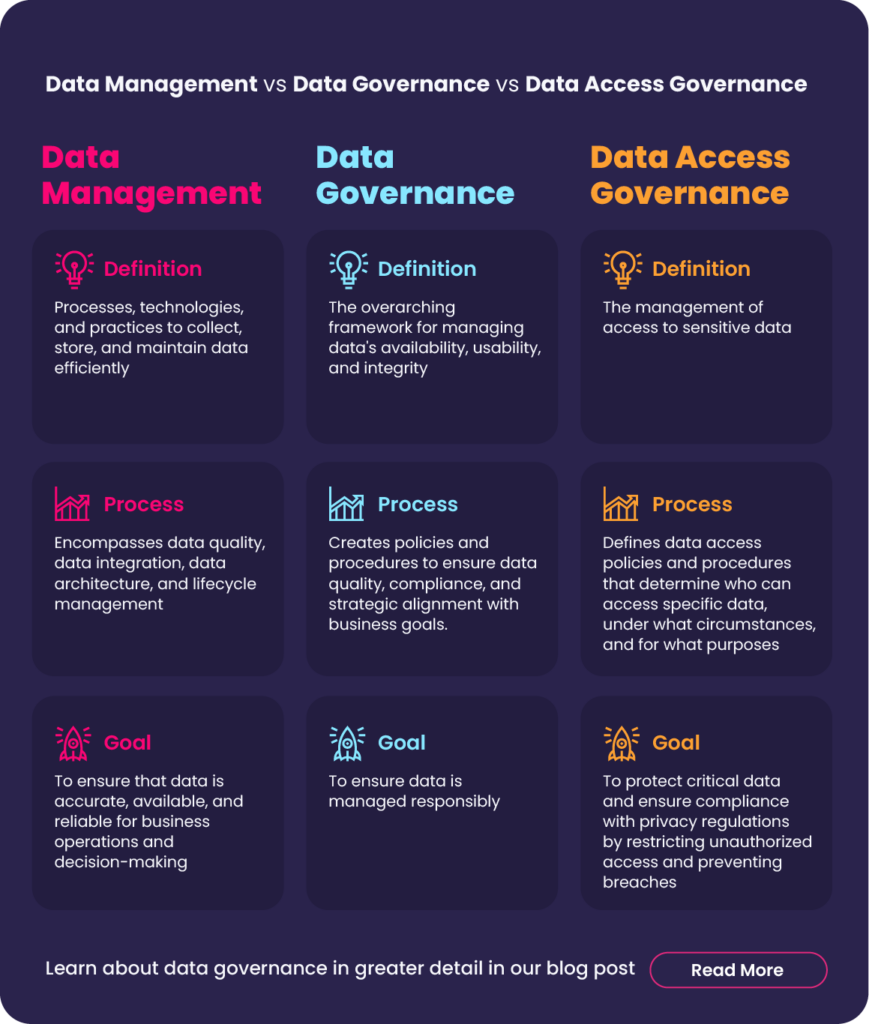
The Benefits of Data Access Governance
As organizations handle increasing volumes of data, both structured and unstructured, DAG plays a critical role in maintaining data integrity and security.
Enhanced Data Security
Robust access controls implemented through DAG ensure that only authorized users access sensitive information. This minimizes the risk of potential data breaches, safeguards valuable assets, and maintains customer trust.
Streamlined Regulatory Compliance
DAG helps you comply with data protection regulations like GDPR and HIPAA. Detailed audit trails and strictly enforced access policies enable you to demonstrate compliance and avoid potential fines and legal issues.
Improved Operational Efficiency
Since data classification and prioritization are automated with DAG, you can focus your resources on high-priority data. At the same time, critical information is accessible and managed effectively, which improves overall efficiency.
Increased Data Visibility and Transparency
DAG provides insights into data access patterns to help you make informed decisions and identify potential security risks. This fosters accountability and ensures data usage aligns with your business goals and ethical standards.
DAG can be especially useful for managing and protecting unstructured data.
Managing Access to Structured and Unstructured Data
Structured data refers to information that is highly organized and easily searchable in databases, often stored in rows and columns. Examples include customer records, financial transactions, and inventory data.
Unstructured data, on the other hand, lacks a predefined format and includes emails, documents, social media posts, and multimedia files. This data type can currently make up to 80%-90% of an organization’s data and its volume is growing rapidly.
Data without structure presents unique challenges. It is not easy to organize or analyze. However, it often contains critical business information and sensitive details, such as intellectual property, customer communications, and confidential documents.
DAG uses automation to classify and prioritize this type of data based on its sensitivity and importance.
Once classified and prioritized, you can implement targeted security measures to reduce the risk of data breaches.
Common Data Governance Challenges
Organizations often face challenges when implementing and maintaining effective data access governance frameworks. Here are some of the most common ones:
Complexity of Access Controls
Managing access controls across various systems and applications can be complex. You may struggle to implement consistent policies due to diverse technology stacks and legacy systems.
Ensuring that access controls are both comprehensive and adaptable requires significant effort and technical expertise.
Balancing Security and Accessibility
One of DAG’s primary goals is to protect data while ensuring that authorized users can access the information they need.
Overly restrictive access policies can hinder productivity, while lax controls can lead to security vulnerabilities. Striking this balance can be challenging.
Managing User Roles and Permissions
Sometimes, defining and managing user roles and permissions can be challenging. As roles and responsibilities change, keeping access rights up to date is essential.
Failure to do so can result in an improper level of access or excessive permissions granted to users, which increases the risk of data breaches.
Monitoring and Auditing Data Access
You need continuous monitoring and auditing of data access for detecting unauthorized access and ensuring compliance. However, implementing effective monitoring systems can be resource-intensive and may require sophisticated tools to analyze access patterns and identify anomalies.
Adapting to Regulatory Changes
Data protection regulations, such as GDPR, HIPAA, and CCPA, require organizations to implement strict access controls. If you’re a global organization, you may find it difficult to keep up with regulatory changes and ensure ongoing compliance, especially when dealing with multiple regulatory frameworks.
Of course, a strategic approach that includes robust access control policies, continuous monitoring, and regular audits can mitigate all these challenges. You’d also need appropriate technologies.
Technologies Used Govern Access to Sensitive Data
Effective and comprehensive data access governance relies on several key technologies to manage data access according to regulations. Three essential technologies in this domain are:
Data Security Posture Management (DSPM)
DSPM provides a comprehensive view of your data security posture. It helps identify data assets across cloud and on-premises environments, assess security risks, and ensure compliance with data protection regulations.
With continuous monitoring and automated remediation capabilities, DSPM enables you to proactively manage and secure your data.
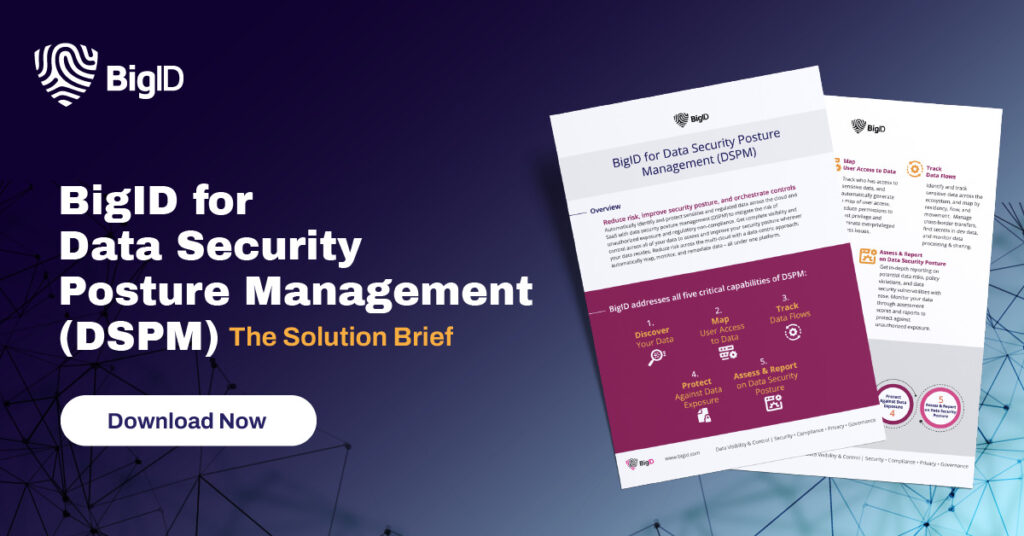
Identity and Access Management (IAM)
IAM solutions use RBAC and ABAC to enable you to define and manage user identities and enforce access policies across systems and applications. By controlling who can view the information, IAM helps prevent unauthorized access and reduce the risk of data breaches.
Data Loss Prevention (DLP)
DLP technologies are designed to prevent data leaks by monitoring and controlling data movement. DLP solutions identify sensitive data, enforce policies to restrict data transfer, and alert administrators to potential security violations.
By protecting data from unauthorized disclosure, DLP helps you maintain compliance and safeguard sensitive information.
Together, these technologies form a robust framework for effective data access governance, ensuring data security and compliance.
BigID’s Data Access Governance Solution
BigID simplifies data access governance with automated tools that identify and manage sensitive data across an organization. By implementing a zero-trust approach, our platform can help you control who accesses data, ensuring only authorized users can view or modify sensitive information.
Learn more about how our AI-powered solution can help you with your organization’s data access governance: AI Automation for Data Governance.



